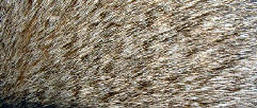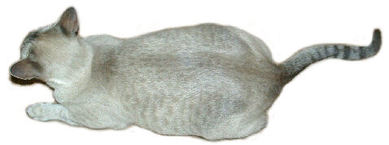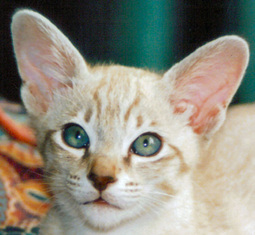|
Tabby Tonkinese
Photos & article © Linda Vousden First, it helps to understand the difference between 'Agouti' & 'Tabby', because we often use the word tabby when we actually mean agouti. Agouti - is the name of the gene that causes alternating bands of the cat's colour and yellow colour along the individual hair shafts, giving light and dark bands of colour in each hair (ticking). It is a dominant gene (A-), the recessive version (i.e allele) being non-agouti (aa), which allows the colour to be fully produced along the length of the hair shaft without banding. Unless the cat has a dominant agouti gene it cannot properly show the tabby pattern - and indeed it will not be a tabby cat. Tabby - is a separate gene that produces the different types of tabby-pattern - ticked, mackerel, spotted, classic or a combination of them. Believe it or not, all cats have a tabby pattern, but it is only when the agouti gene is dominant that we can see it clearly. |
In all agouti cats the ears, face, legs, feet and tail have standard markings regardless of breed - the scarab (‘M’) on the forehead, thin pencil lines on the cheeks, pale spectacles around the eyes, spotted whisker pads, one or two dots on the side of the nose, thumb-prints on the backs of the ears, solid coloured hocks and a half-moon on the outside of the back foot. Most tabbies will also have stripes on the fore and hind legs, one or two necklaces (that may be broken or unbroken) and a partially ringed tail with a solid coloured tip
|
Tabby is a pattern of colour, it has four versions.
The pictures are clearer if you sit back from your screen.
The pictures are clearer if you sit back from your screen.
The Tonkinese have inherited their tabby genes from the Burmese and Siamese, neither of which have had to breed for clarity of the tabby pattern. Therefore, the Tonkinese may be ticked, mackerel, mackerel-spotted, classic, classic-spotted or a combination of the ticked and mackerel patterns. In the mink coat-pattern the tabby pattern must be evident over the coat but the body markings should be a paler shade of the tabby markings on the points.
|
'Tabby' Effect on Nose & Paw Leathers
The manipulation of colour by the agouti and tabby genes is not restricted to the fur, it also has an effect on the nose and paw leathers of the cat. In a tortoiseshell cat we can see that both the fur and leathers show a mottled colouration – in tabbies the effect on colour is to restrict it in certain areas. The nose leather of a young tabby kitten may appear to be solid in colour but, as the kitten grows, the colouration appears to seep back to the edges of the nose – eventually leaving a pinkish nose with a pencil-line of colour around the edge. The paws may also appear to be solidly pigmented in a young tabby kitten but a mature tabby will invariably have pinkish patches on its paws – whatever its base colour is. |
The Tonkinese Tabby Pattern In : -
|
Red, Cream & Apricot (Orange series)
The Non-Orange Series Tonkinese The Non-Agouti Tortoishell Tonkinese The Tortie-Tabby Tonkinese (akaTorbies) |
The orange-making gene inhibits the complete masking of the underlying tabby-pattern, so some tabby markings will probably be seen on the points of Red, Cream and Apricot cats, this doesn't make them tabbies. However breeders should avoid breeding with heavily marked orange cats because the poor masking of the tabby markings is almost always inherited by the kittens. Tabby markings on the body of an orange Tonkinese are quite undesireable - and a notable fault in a show cat.
Brown, Blue, Chocolate, Lilac, Caramel, Cinnamon and Fawn. If the cat is agouti you should expect to see that markings described previously. Some non-agouti cats may exhibit tabby or ghost-tabby markings, and if they do it is more usually on the points. Sometimes the ghosting in non-agouti kittens will reduce or even disappear as the kitten grows and has successive moults. However, tabby markings are a notable fault in a non-agouti adult show cat. The Tortoishell cat combines both orange and non-orange. On the non-orange colours there should be no tabby markings. The intermingled orange colours on the points may exhibit some ghost-tabby markings, but on the body the orange colours should be free of tabby-markings in a show cat. Agouti Tonkinese with randomly intermingled patches of orange - there should be clear tabby markings on both the orange and non-orange areas of the cat. The tabby markings on the points should be darker than on the body. |







